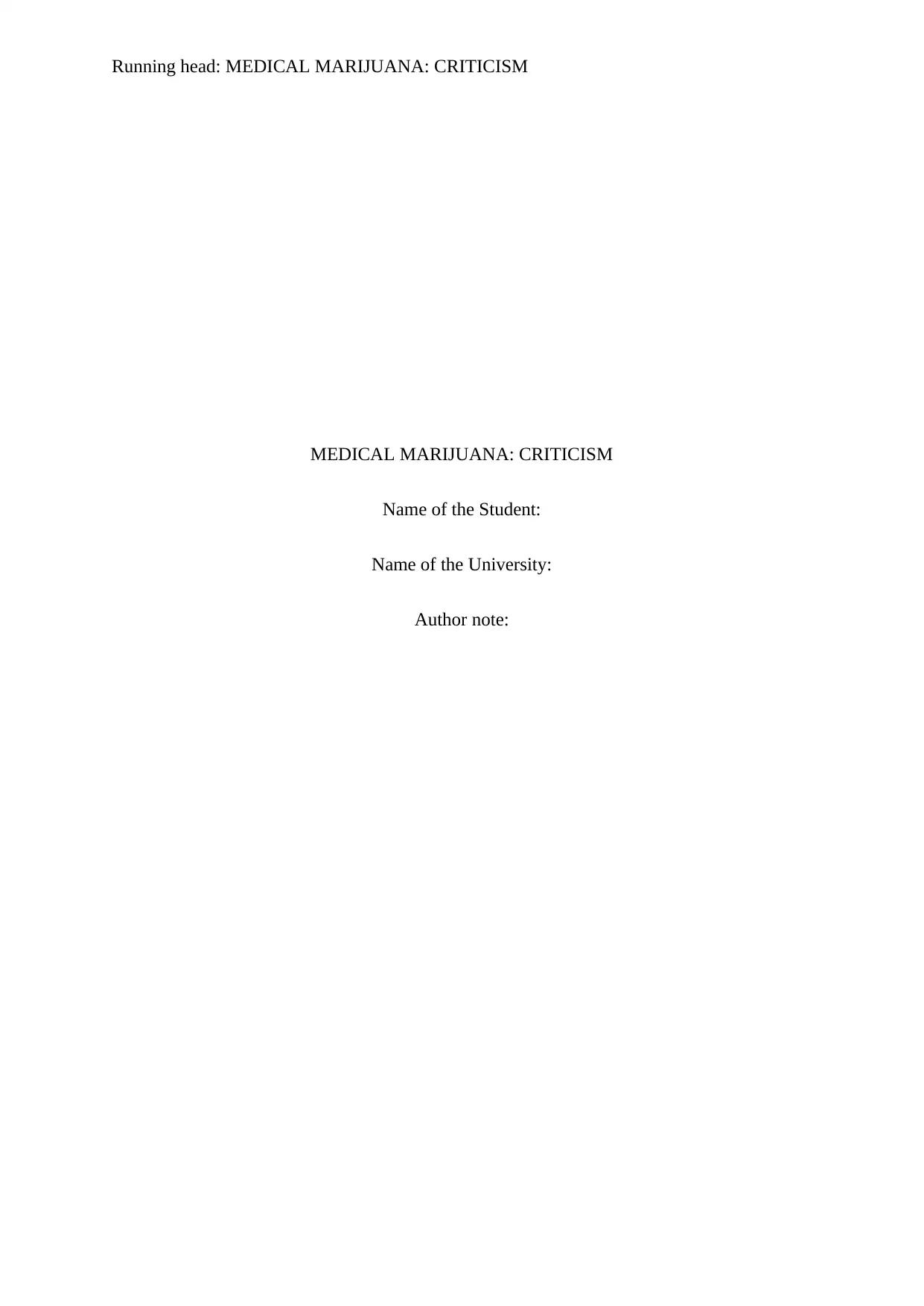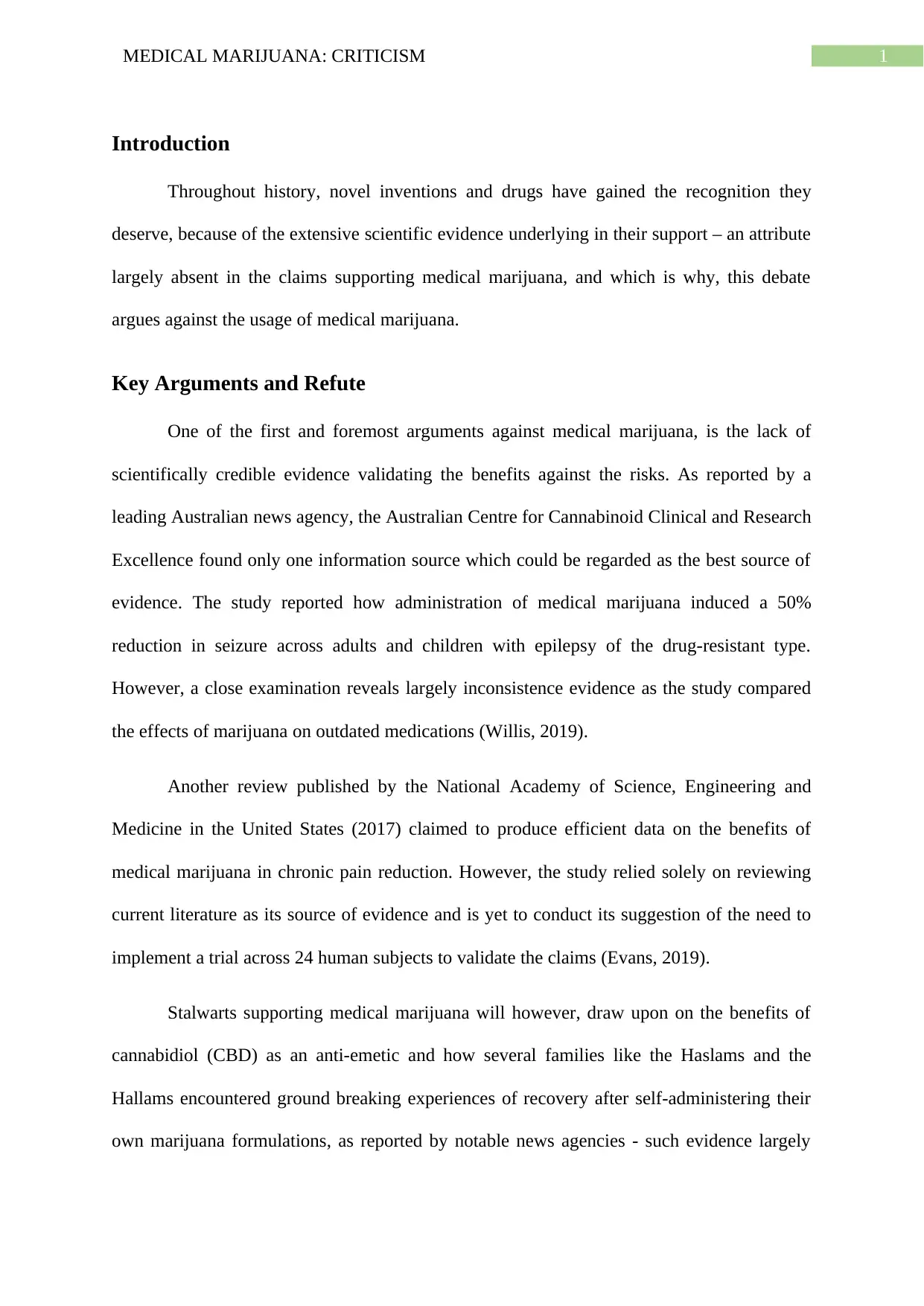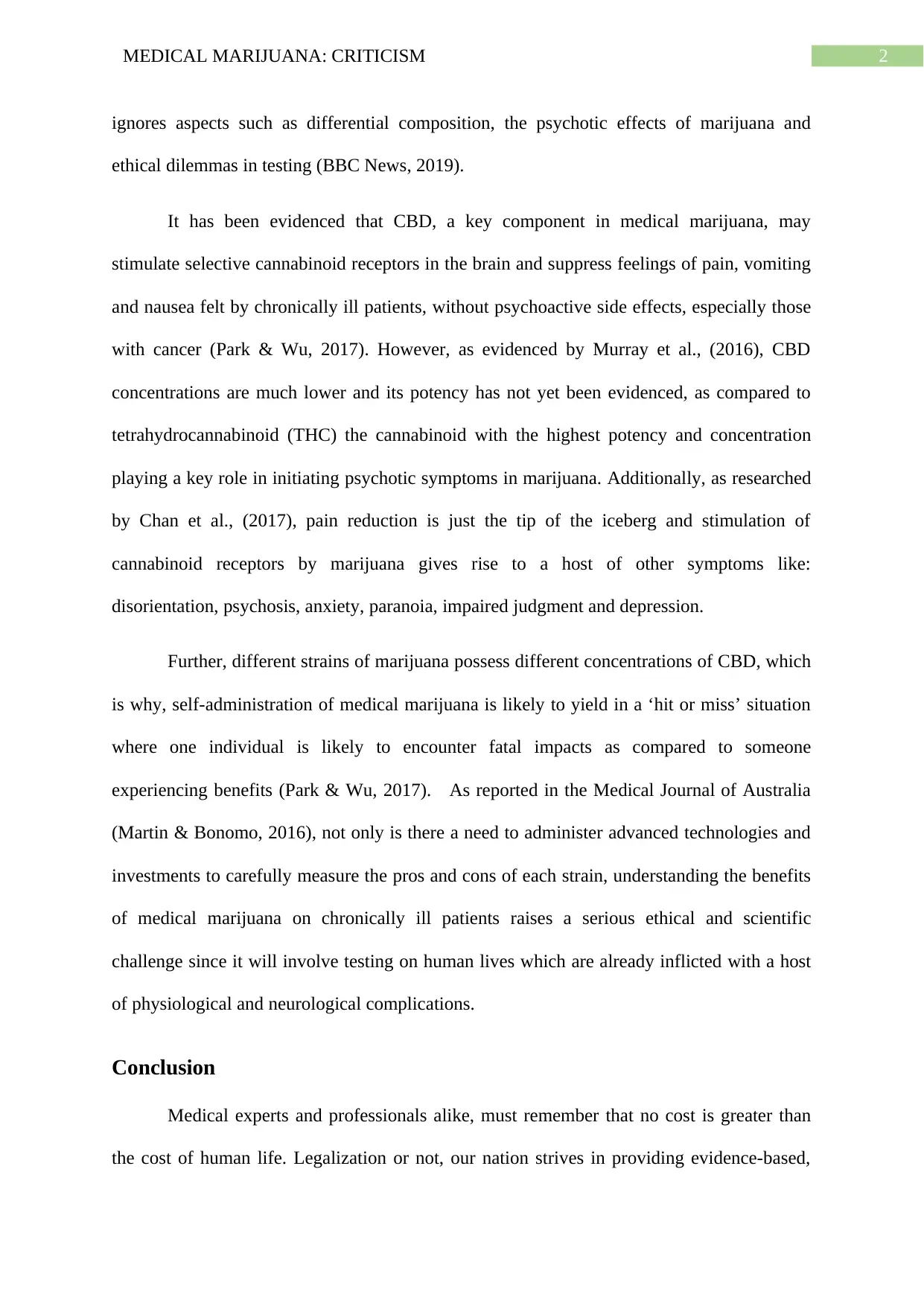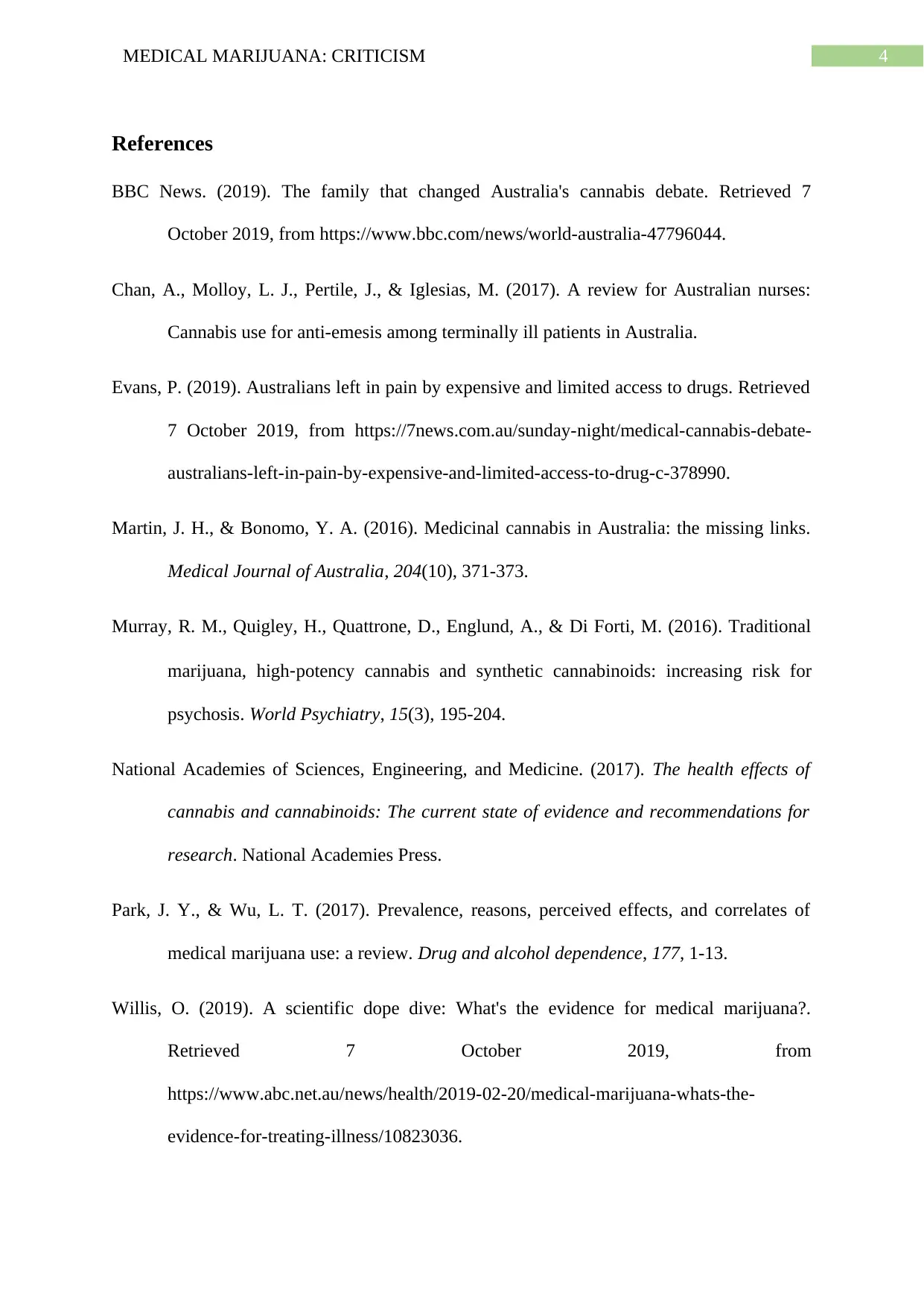Critical Analysis of Medical Marijuana in the Australian Context
VerifiedAdded on 2022/09/27
|6
|995
|27
Essay
AI Summary
This essay critically examines the arguments against the use of medical marijuana, focusing on the Australian context. It highlights the lack of scientifically credible evidence supporting its benefits, referencing studies that reveal inconsistent data and reliance on outdated medications. The essay also discusses the potential risks associated with medical marijuana, such as the varying concentrations of CBD and THC in different strains, which can lead to unpredictable effects, including disorientation, psychosis, and impaired judgment. Furthermore, it raises ethical and scientific challenges related to testing medical marijuana on chronically ill patients. The essay concludes by emphasizing the importance of evidence-based healthcare and the need for scientific validation before widespread implementation.

Running head: MEDICAL MARIJUANA: CRITICISM
MEDICAL MARIJUANA: CRITICISM
Name of the Student:
Name of the University:
Author note:
MEDICAL MARIJUANA: CRITICISM
Name of the Student:
Name of the University:
Author note:
Paraphrase This Document
Need a fresh take? Get an instant paraphrase of this document with our AI Paraphraser

1MEDICAL MARIJUANA: CRITICISM
Introduction
Throughout history, novel inventions and drugs have gained the recognition they
deserve, because of the extensive scientific evidence underlying in their support – an attribute
largely absent in the claims supporting medical marijuana, and which is why, this debate
argues against the usage of medical marijuana.
Key Arguments and Refute
One of the first and foremost arguments against medical marijuana, is the lack of
scientifically credible evidence validating the benefits against the risks. As reported by a
leading Australian news agency, the Australian Centre for Cannabinoid Clinical and Research
Excellence found only one information source which could be regarded as the best source of
evidence. The study reported how administration of medical marijuana induced a 50%
reduction in seizure across adults and children with epilepsy of the drug-resistant type.
However, a close examination reveals largely inconsistence evidence as the study compared
the effects of marijuana on outdated medications (Willis, 2019).
Another review published by the National Academy of Science, Engineering and
Medicine in the United States (2017) claimed to produce efficient data on the benefits of
medical marijuana in chronic pain reduction. However, the study relied solely on reviewing
current literature as its source of evidence and is yet to conduct its suggestion of the need to
implement a trial across 24 human subjects to validate the claims (Evans, 2019).
Stalwarts supporting medical marijuana will however, draw upon on the benefits of
cannabidiol (CBD) as an anti-emetic and how several families like the Haslams and the
Hallams encountered ground breaking experiences of recovery after self-administering their
own marijuana formulations, as reported by notable news agencies - such evidence largely
Introduction
Throughout history, novel inventions and drugs have gained the recognition they
deserve, because of the extensive scientific evidence underlying in their support – an attribute
largely absent in the claims supporting medical marijuana, and which is why, this debate
argues against the usage of medical marijuana.
Key Arguments and Refute
One of the first and foremost arguments against medical marijuana, is the lack of
scientifically credible evidence validating the benefits against the risks. As reported by a
leading Australian news agency, the Australian Centre for Cannabinoid Clinical and Research
Excellence found only one information source which could be regarded as the best source of
evidence. The study reported how administration of medical marijuana induced a 50%
reduction in seizure across adults and children with epilepsy of the drug-resistant type.
However, a close examination reveals largely inconsistence evidence as the study compared
the effects of marijuana on outdated medications (Willis, 2019).
Another review published by the National Academy of Science, Engineering and
Medicine in the United States (2017) claimed to produce efficient data on the benefits of
medical marijuana in chronic pain reduction. However, the study relied solely on reviewing
current literature as its source of evidence and is yet to conduct its suggestion of the need to
implement a trial across 24 human subjects to validate the claims (Evans, 2019).
Stalwarts supporting medical marijuana will however, draw upon on the benefits of
cannabidiol (CBD) as an anti-emetic and how several families like the Haslams and the
Hallams encountered ground breaking experiences of recovery after self-administering their
own marijuana formulations, as reported by notable news agencies - such evidence largely

2MEDICAL MARIJUANA: CRITICISM
ignores aspects such as differential composition, the psychotic effects of marijuana and
ethical dilemmas in testing (BBC News, 2019).
It has been evidenced that CBD, a key component in medical marijuana, may
stimulate selective cannabinoid receptors in the brain and suppress feelings of pain, vomiting
and nausea felt by chronically ill patients, without psychoactive side effects, especially those
with cancer (Park & Wu, 2017). However, as evidenced by Murray et al., (2016), CBD
concentrations are much lower and its potency has not yet been evidenced, as compared to
tetrahydrocannabinoid (THC) the cannabinoid with the highest potency and concentration
playing a key role in initiating psychotic symptoms in marijuana. Additionally, as researched
by Chan et al., (2017), pain reduction is just the tip of the iceberg and stimulation of
cannabinoid receptors by marijuana gives rise to a host of other symptoms like:
disorientation, psychosis, anxiety, paranoia, impaired judgment and depression.
Further, different strains of marijuana possess different concentrations of CBD, which
is why, self-administration of medical marijuana is likely to yield in a ‘hit or miss’ situation
where one individual is likely to encounter fatal impacts as compared to someone
experiencing benefits (Park & Wu, 2017). As reported in the Medical Journal of Australia
(Martin & Bonomo, 2016), not only is there a need to administer advanced technologies and
investments to carefully measure the pros and cons of each strain, understanding the benefits
of medical marijuana on chronically ill patients raises a serious ethical and scientific
challenge since it will involve testing on human lives which are already inflicted with a host
of physiological and neurological complications.
Conclusion
Medical experts and professionals alike, must remember that no cost is greater than
the cost of human life. Legalization or not, our nation strives in providing evidence-based,
ignores aspects such as differential composition, the psychotic effects of marijuana and
ethical dilemmas in testing (BBC News, 2019).
It has been evidenced that CBD, a key component in medical marijuana, may
stimulate selective cannabinoid receptors in the brain and suppress feelings of pain, vomiting
and nausea felt by chronically ill patients, without psychoactive side effects, especially those
with cancer (Park & Wu, 2017). However, as evidenced by Murray et al., (2016), CBD
concentrations are much lower and its potency has not yet been evidenced, as compared to
tetrahydrocannabinoid (THC) the cannabinoid with the highest potency and concentration
playing a key role in initiating psychotic symptoms in marijuana. Additionally, as researched
by Chan et al., (2017), pain reduction is just the tip of the iceberg and stimulation of
cannabinoid receptors by marijuana gives rise to a host of other symptoms like:
disorientation, psychosis, anxiety, paranoia, impaired judgment and depression.
Further, different strains of marijuana possess different concentrations of CBD, which
is why, self-administration of medical marijuana is likely to yield in a ‘hit or miss’ situation
where one individual is likely to encounter fatal impacts as compared to someone
experiencing benefits (Park & Wu, 2017). As reported in the Medical Journal of Australia
(Martin & Bonomo, 2016), not only is there a need to administer advanced technologies and
investments to carefully measure the pros and cons of each strain, understanding the benefits
of medical marijuana on chronically ill patients raises a serious ethical and scientific
challenge since it will involve testing on human lives which are already inflicted with a host
of physiological and neurological complications.
Conclusion
Medical experts and professionals alike, must remember that no cost is greater than
the cost of human life. Legalization or not, our nation strives in providing evidence-based,
⊘ This is a preview!⊘
Do you want full access?
Subscribe today to unlock all pages.

Trusted by 1+ million students worldwide

3MEDICAL MARIJUANA: CRITICISM
credible healthcare and thus every decision, new and old alike, must be implemented once the
benefits validated by science outweighs the possible risks.
credible healthcare and thus every decision, new and old alike, must be implemented once the
benefits validated by science outweighs the possible risks.
Paraphrase This Document
Need a fresh take? Get an instant paraphrase of this document with our AI Paraphraser

4MEDICAL MARIJUANA: CRITICISM
References
BBC News. (2019). The family that changed Australia's cannabis debate. Retrieved 7
October 2019, from https://www.bbc.com/news/world-australia-47796044.
Chan, A., Molloy, L. J., Pertile, J., & Iglesias, M. (2017). A review for Australian nurses:
Cannabis use for anti-emesis among terminally ill patients in Australia.
Evans, P. (2019). Australians left in pain by expensive and limited access to drugs. Retrieved
7 October 2019, from https://7news.com.au/sunday-night/medical-cannabis-debate-
australians-left-in-pain-by-expensive-and-limited-access-to-drug-c-378990.
Martin, J. H., & Bonomo, Y. A. (2016). Medicinal cannabis in Australia: the missing links.
Medical Journal of Australia, 204(10), 371-373.
Murray, R. M., Quigley, H., Quattrone, D., Englund, A., & Di Forti, M. (2016). Traditional
marijuana, high‐potency cannabis and synthetic cannabinoids: increasing risk for
psychosis. World Psychiatry, 15(3), 195-204.
National Academies of Sciences, Engineering, and Medicine. (2017). The health effects of
cannabis and cannabinoids: The current state of evidence and recommendations for
research. National Academies Press.
Park, J. Y., & Wu, L. T. (2017). Prevalence, reasons, perceived effects, and correlates of
medical marijuana use: a review. Drug and alcohol dependence, 177, 1-13.
Willis, O. (2019). A scientific dope dive: What's the evidence for medical marijuana?.
Retrieved 7 October 2019, from
https://www.abc.net.au/news/health/2019-02-20/medical-marijuana-whats-the-
evidence-for-treating-illness/10823036.
References
BBC News. (2019). The family that changed Australia's cannabis debate. Retrieved 7
October 2019, from https://www.bbc.com/news/world-australia-47796044.
Chan, A., Molloy, L. J., Pertile, J., & Iglesias, M. (2017). A review for Australian nurses:
Cannabis use for anti-emesis among terminally ill patients in Australia.
Evans, P. (2019). Australians left in pain by expensive and limited access to drugs. Retrieved
7 October 2019, from https://7news.com.au/sunday-night/medical-cannabis-debate-
australians-left-in-pain-by-expensive-and-limited-access-to-drug-c-378990.
Martin, J. H., & Bonomo, Y. A. (2016). Medicinal cannabis in Australia: the missing links.
Medical Journal of Australia, 204(10), 371-373.
Murray, R. M., Quigley, H., Quattrone, D., Englund, A., & Di Forti, M. (2016). Traditional
marijuana, high‐potency cannabis and synthetic cannabinoids: increasing risk for
psychosis. World Psychiatry, 15(3), 195-204.
National Academies of Sciences, Engineering, and Medicine. (2017). The health effects of
cannabis and cannabinoids: The current state of evidence and recommendations for
research. National Academies Press.
Park, J. Y., & Wu, L. T. (2017). Prevalence, reasons, perceived effects, and correlates of
medical marijuana use: a review. Drug and alcohol dependence, 177, 1-13.
Willis, O. (2019). A scientific dope dive: What's the evidence for medical marijuana?.
Retrieved 7 October 2019, from
https://www.abc.net.au/news/health/2019-02-20/medical-marijuana-whats-the-
evidence-for-treating-illness/10823036.

5MEDICAL MARIJUANA: CRITICISM
⊘ This is a preview!⊘
Do you want full access?
Subscribe today to unlock all pages.

Trusted by 1+ million students worldwide
1 out of 6
Your All-in-One AI-Powered Toolkit for Academic Success.
+13062052269
info@desklib.com
Available 24*7 on WhatsApp / Email
![[object Object]](/_next/static/media/star-bottom.7253800d.svg)
Unlock your academic potential
Copyright © 2020–2025 A2Z Services. All Rights Reserved. Developed and managed by ZUCOL.
